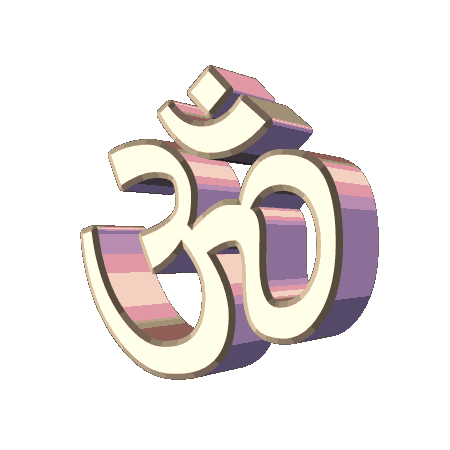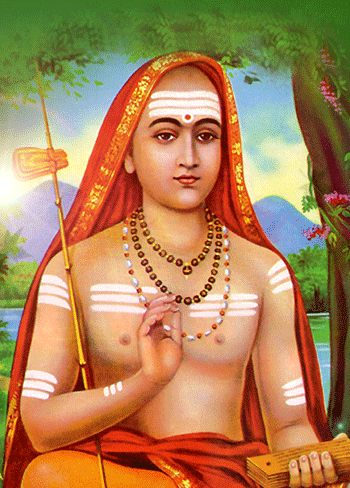|
The
natural or innate contact continues as long as the
buddhi, but on realisation of the Self it proves to
be false. The third mentioned contact is broken
when it is discovered by experience that there is
no sort of contact of anything at all with the
Self, which is being. The second mentioned contact,
that born of past karma, ceases to exist on the
destruction of innate tendencies [vasanas].
In the deep sleep state, when the body is inert,
the ego is fully merged [in the causal
ignorance]. The ego is half manifest in the
dream state, and its being fully manifest is the
waking state. It is the mode or modification of
thought [with its latent tendencies] that
creates the inner world of dreams in the dream
state and the outer world in the waking state. The
subtle body, which is the material cause of mind
and ego, experiences the three states and also
birth and death.
Maya of the causal body has its powers of
projecting [rajas] and veiling
[tamas]. It is the projecting power that
creates everything from the subtle body to the
gross universe of names and forms. These are
produced in the Sat-chit-ananda
[Being-consciousness-bliss] like foam in
the ocean. The veiling power operates in such a way
that internally the distinction between subject and
object cannot be perceived, and externally that
between Brahman and the phenomenal world. This
indeed is the cause of samsara. The individual with
his reflected light of consciousness is the subtle
body existing in close proximity with the Self that
is the vyavaharika [the empirical Self].
This individual character of the empirical Self
appears in the Witness or Sakshi also through false
superimposition. But on the extinction of the
veiling power [tamas], the distinction
betweenWwitness and the empirical Self becomes
clear; and the superimposition also drops away.
Similarly, Brahman shines as the phenomenal world
of names and forms only through the effect of the
veiling power which conceals the distinction
between them. When the veiling ends, the
distinction between the two is perceived, for none
of the activities of the phenomenal world exist in
Brahman.
Of the five characteristics – being,
consciousness, bliss, name and form – the
first three pertain to Brahman and name and form to
the world. The three aspects of being,
consciousness and bliss exist equally in the five
elements of ether, air, fire, water and earth and
in devas [gods], animals, men, etc.,
whereas the names and forms are different.
Therefore, be indifferent to names and forms,
concentrate on being-consciousness-bliss and
constantly practise samadhi [identity with
Brahman] within the Heart or outside.
This practice of samadhi [identity with
Brahman] is of two kinds: savikalpa [in
which the distinction between knower, knowledge and
known is not lost] and Nirvikalpa [in which
the above distinction is lost]. Savikalpa
samadhi again is of two kinds: that which is
associated with words [sound], and
meditation on one's own consciousness as the
Witness of thought forms such as desire, which is
savikalpa samadhi [internal], associated
with [cognisable] objects. Realising one's
Self as "I am being-consciousness-bliss without
duality, unattached, self-effulgent", is savikalpa
samadhi [internal] associated with words
[sound]. Giving up both objects and sound
forms of the aforesaid two modes of samadhi and
being completely absorbed in the bliss experienced
by the realisation of the Self is Nirvikalpa
samadhi [internal]. In this state steady
abidance is obtained, like the unflickering flame
of a light kept in a place free from wind. So also,
in the Heart, becoming indifferent to external
objects of name and form and perceiving only Being
of [or as] Sat, is savikalpa samadhi
[external] associated with objects; and
being aware continually of that Sat [true
Being] as the unbroken single essence of
Brahman is savikalpa samadhi [external]
associated with words [sound]. After these
two experiences, Being, which is uninterrupted like
the waveless ocean, is Nirvikalpa samadhi
[external]. One who meditates should spend
his time perpetually in these six kinds of samadhi.
By these, the attachment to the body is destroyed
and the mind that perpetually abides in the Supreme
Self [Paramatman] wherever it may wander,
is everywhere spontaneously in samadhi. By this
constant practice of samadhi, the Supreme Self, who
is both highest and lowliest, who encompasses
Paramatman as well as jivatman is directly
experienced, and then the knot of the Heart is
loosened; all doubts are destroyed and all karmas
[activities] cease too.
Of the three modes of individual being, the limited
self [as in deep sleep], the empirical self
[as in the waking state] and the dreaming
self, only the individual limited by the deep sleep
state is the true Self [Paramarthika]. Even
he is but an idea. The Absolute alone is the true
Self. In reality and by nature He is Brahman
Itself, only superimposition creates the
limitations of individuality in the Absolute. It is
to the paramarthika jiva that the identity of Tat
Tvam Asi ["That thou art"] and other great
texts of the Upanishads applies, and not to
any other. The great maya [the superimposition
without beginning] with her veiling and
projecting power [tamas and rajas] veils
the single indivisible Brahman and, in that
Brahman, creates the world and individuals. The
individual [jiva], a concept of the
empirical self in the buddhi, is indeed the actor
and enjoyer and the entire phenomenal world is its
object of enjoyment. From time without beginning,
till the attainment of liberation, individual and
world have an empirical existence. They are both
empirical. The empirical individual appears to have
the power of sleep in the shape of the veiling and
projecting powers. It is associated with
consciousness. The power covers first the
individual empirical self and the cognised
universe, and then these are imagined in dream.
These dream perceptions and the individual who
perceives them are illusory, because they exist
only during the period of dream experience. We
affirm their illusory nature, because on waking up
from dream no one sees the dream, no one sees the
dream objects. The dreaming self experiences the
dream world as real, while the empirical self
experiences the empirical world as real but, when
the paramarthika jiva is realised, knows it to be
unreal. The paramarthika jiva, as distinguished
from those of the waking and dream experiences, is
identical with Brahman. He has no "other". If he
does see any "other", he knows it to be
illusory.
The sweetness, liquidity, and coldness of water are
characteristics present equally in waves and foam.
So, too, the being-consciousness-bliss character of
the Self [Paramarthika] is present in the
empirical self and through him in the dream self
also, because of their being only illusory
creations in the Self. The foam with its qualities,
such as coldness, subsides in the waves, the waves
with their characteristics, such as liquidity,
subside in the water, and the ocean alone exists as
at first. Similarly, the dream self and its objects
are absorbed in the empirical self; then the
empirical world with its characteristics is
absorbed in the Paramarthika and, as at first,
being-consciousness-bliss which is Brahman shines
alone.
|



